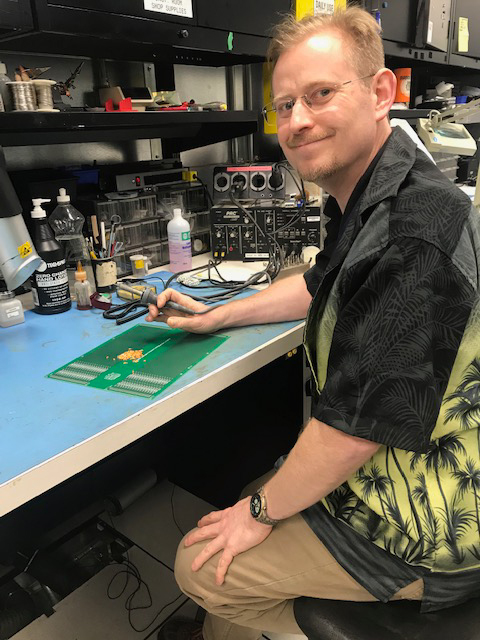The building and benefit of the printed circuit board
By Lookout on Jan 29, 2020 with Comments 0
Ashley Evans, FMF ~
An Electronics Technician employed at Fleet Maintenance Facility (FMF) Cape Breton in the Electronics Shop is making exciting connections through his work on printed circuit boards (PCBs).
Dax Ryn, a BCIT graduate in both Electronic Engineering Technology and Biomedical Engineering Technology, worked in private industry for 14-years prior to coming to FMF Cape Breton in 2018. One of his first major projects has been to create a printed circuit board for use on an HF Transmitter, while identifying a capability within FMF to not only serve the Fleet but other shops within FMF.
“I enjoy seeing problems and solving them. It feels rewarding to fix something that is broken,” said Ryn.
He has not only been creating custom circuit boards for the RCN, but has been teaching apprentices how to do the same.
“They [PCBs] are very useful if you want to diagnose problems in a system,” he said. “These boards can be made as smaller pieces to add as a replacement part or as an add-on – with an improved design or update of programing that may no longer be obtainable in the outside market. Extender cards can also be made to extend out as part of the system which can be used to test and measure a current system.”
In the fall of 2019, Ryn created a PCB which was installed on an HF Transmitter aboard HMCS Chicoutimi. The challenge of accessing the previous board and the need to be able to test it while in operation is what motivated the creation of this custom circuit board. The PCB allowed the RCN the flexibility to probe either between the transmitter boards or on the PCB extender.
Printed circuit boards are a valuable resource when testing a system that is difficult or unsafe to reach, or to test a system while the system is kept running. “It is very useful if you want to diagnose problems in a system,” said Ryn. He continued that it is also a durable way to make a test and measurement capability within FMF. In addition to services provided for the Fleet which are installed on RCN Frigates and Submarines, PCBs can be custom made for different shops throughout FMF to test and measure internal systems, add lights or an electronic control to a system, or replace damaged boards.
“We have this capability here at FMF and it would be a waste not to utilize it,” Ryn explained. “A lot of people are into this make movement and there is no reason to not pursue your actual dreams – they are obtainable.”
Ryn takes pride in teaching Electronics Technician Apprentices how to create PCBs, which is now mandated in the Electronics apprenticeship. This process begins with a schematic design of the board that shows logical connections in layout software, which is then submitted to the PCB manufacturer. “There are near infinite ways to create a PCB, and usually 4 or 5 ways that are best,” Ryn explained. “This allows for creativity and we ultimately have the final choice of which PCB layout we use.” Additionally, the Electronics Technician has freedom of choosing font and arrow design on the PCB. When the production house completes the designed PCB, it is sent back to FMF where its components are fitted by an Electronics Technician.
Ryn says that with PCBs, although knowledge is easy to obtain, you slowly inform and start from the bottom as you learn the process. The apprentices can use test boards to practice and make changes as necessary. “It is very challenging and very impressive,” he said.
To note: PCB boards used to be entirely made in-house at FMF, however it is not possible to make them by hand anymore due to advances in miniaturization.
Filed Under: Top Stories
About the Author:






